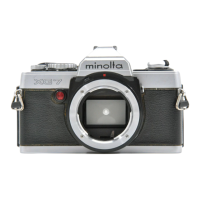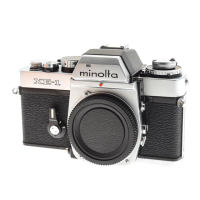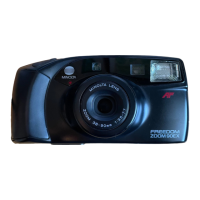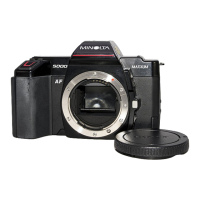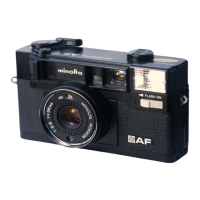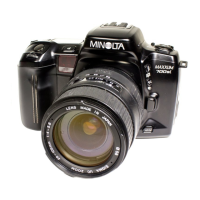SPEED
KNOB
DIAPHRAGM
COUPLING
X-SYNC
FLASHCORD
TERMINAL
LENS
LATCH
DEPTH-OF-FIELD
PREVIEW
Figure 1A
CAMERA CAPSULE
Type: 35mm electronically controlled
SLR with choice between aperture-
preferred or shutter-speed preferred
operation. Electromagnetic release. Full
range of manually calibrated shutter
speeds as well as automatic exposure
control.
Meter: LED readout displays shutter
speed or f/stop which the camera will
automatically program. Silicon photo
diode, full-aperture metering. Film-speed
range — ASA 12 to ASA 3200.
Battery: Two 1.5V silver-oxide batteries
S-76, G-13, MS-76, or RS-76. Negative
ground. Battery compartment at bottom
of camera. Behavior without batteries —
shutter will not release except at
mechanical speeds.
Shutter: Seiko MFC vertically traveling
metal focal-plane shutter. Electronic
shutter-speed control at auto and manual
settings with two mechanically controlled
settings — bulb and 1/100 second. Travel
time — 6.0 to 6.9ms measured across a
20mm distance. Mechanical self-timer.
Lens: Accepts all Minolta MD lenses.
Flange-focal distance 43.7mm (+0.02 —
0) measured from lens-mounting ring to
pressure-plate rails.
Typical current draw with 3V supplied
to battery compartment: Meter — 8.5ma,
Shutter open — 17ma.
Circuit: Components are mounted on a
flexible circuit board. You can replace in
dividual components or the complete
assembly. Three ICs. Memory switch is at
top of camera, metering switch and
release switch are at back of front-plate
assembly (controlled by release button),
power switch is part of mirror-release
combination magnet. Two combination
magnets, one to release mirror and one to
control diaphragm closure. Electro
magnet for shutter-speed control, trigger
switch, and X-sync contacts are shutter
parts.
MINOLTA'S TRENDSETTER
The meteoric rise of the electronic,
super-compact SLRs forced many
camera manufacturers into a game of
catch-up. But Minolta chose to set its
own standards with the XD-11. Among
other innovations, the XD-11 settled the
debate over aperture-preferred vs.
shutter-speed-preferred automation — it
gives you a choice between either mode.
To program the camera for automatic
shutter-speed control, set the mode selec
tor to the "A " (aperture-preferred) position,
Fig. 2. A mechanically controlled shutter-
speed scale now moves into the finder. Fig.
3. When you push the release button part
way, a row of LEDs indicates the shutter
speed which the camera will automatically
select. The appropriate LED lights alongside
the shutter-speed calibration.
Triangle symbols in the LED display
show the range limitations. If the com
bination of light level and diaphragm
opening requires a shutter speed faster
than 1/1000 second, the overrange LED
turns on. The overrange LED indicates
that you're going to get an overexposure
unless you select a smaller diaphragm
opening. If the underrange LED at the
bottom of the display turns on, you're go
ing to get a shutter speed of 1 second or
slower.
When you're using the "A " mode, you
can leave the speed knob at any of the
calibrated shutter speeds — 1 second
through 1/1000 second. The automatic
speed-control circuit disregards the
speed-knob setting. As you select the
f/stop, a tab on the diaphragm-setting
ring rotates the camera's diaphragm-
metering ring. Fig. 1. The diaphragm-
metering ring moves a brush along a
resistance band, thereby programming
the f/stop information.
So far, the XD-11 sounds like most of
the other electronic SLRs. But the XD-11
demonstrates its originality when you
select automatic diaphragm control. Set
ting the mode selector to "S " (shutter-
speed preferred) shifts the diaphragm
scale into the finder, Fig. 4. Now the LED
display indicates the diaphragm opening
which the camera will automatically pro
gram. Also notice in Fig. 4 that the
shutter-speed setting appears in the
finder. At the "A " mode. Fig. 3, a
mechanically controlled mask covers the
shutter-speed display; the speed-knob
setting has no meaning in the aperture-
preferred mode.
For automatic diaphragm control, turn
the diaphragm-setting ring to the smallest
f/stop. A tab on the diaphragm-setting

